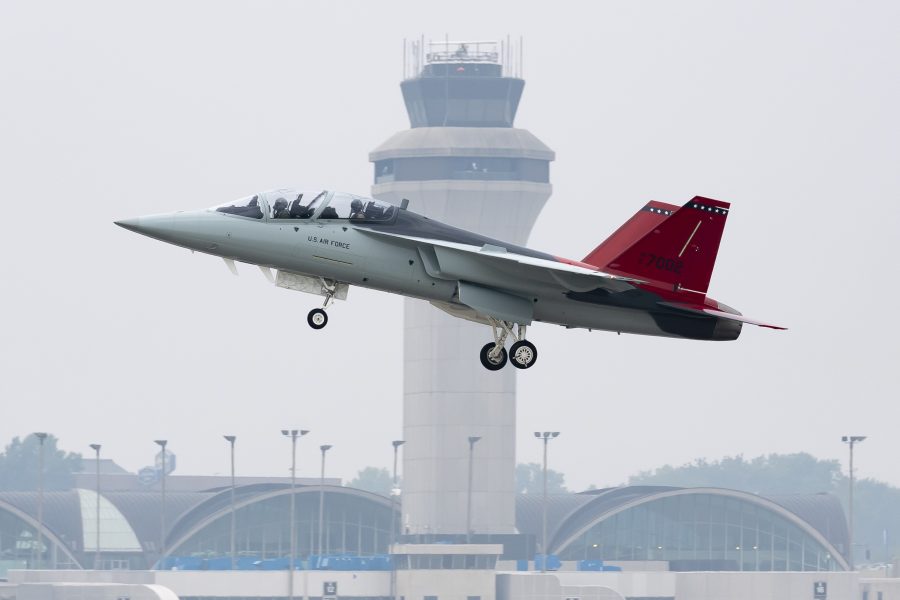DAYTON, Ohio—The Air Force will officially take ownership of its first production-representative T-7A trainer jet “in the coming weeks” and quickly move into flight testing from contractor Boeing’s St. Louis facility, a service official said last week.
After that, the first two Red Hawks will transfer out to Edwards Air Force Base, Calif., in the “September-ish” timeframe to continue testing, T-7 division chief Col. Kirt Cassell told reporters at the Life Cycle Industry Days conference July 31.
In April, Air Force acquisition executive Andrew Hunter announced that the T-7 won’t achieve initial operational capability until early 2027—three years past its original 2024 goal. Then the Government Accountability Office said in May that the Air Force-Boeing relationship was “tenuous,” and predicted Boeing might not even meet the revised 2027 timeline.
Cassell said the Air Force and Boeing have since reset their relationship. “There have been leadership changes,” he said. “At the PEO level and at my level within Boeing, they reorganized kind of wholesale. … And so there was a lot of changeover, which actually just gave us a whole new fresh set of eyes. I have a new deputy that came on the program. So we got a new fresh set of eyes and we really just reinvigorated our relationship.”
In May and June, the first production-representative T-7 started undergoing taxi tests, then took its first official flight with an Air Force pilot.
Behind the scenes, Cassell said, the Air Force and Boeing have been working together to ensure flight testing can start as soon as the first jet, dubbed T-2 or ATP-2, is officially transferred to the Air Force.
“The team, collectively Boeing and the Air Force, have been working overtime,” Cassell said. “Like I’m not kidding, working overtime, late nights, to get through acceptance. We should be accepting that aircraft here in the coming weeks. Once that’s completed, we’ve done a whole lot of work to get ready for flight tests. We’ve completed the appropriate test readiness reviews, those are done. We’ve completed the appropriate test planning requirements.”
Shortly after ATP-2 is accepted by the Air Force, the service hopes to take ownership of a second aircraft, called T-1 or ATP-1. The two airframes will test different factors—flight sciences and loads, respectively, Cassell said.
“There’s little to nothing standing in our way to getting this jet, ATP-2, up and running,” Cassell said. “We’ll start flight tests at St. Louis. And then in or around the September-ish timeframe is when we’ll transition APT-2 and then, following up on that, APT-1 out to Edwards for continued flight testing.”
Getting the T-7 back on track and avoiding any more delays will likely be crucial for satisfying lawmakers who have expressed concerns about the program. Hailed at its unveiling as proving how digital engineering and design are breakthrough technologies for accelerating product to market, the first production-representative aircraft went from drawing board to first flight in 36 months.
Digital design is “completely transforming how we’re doing systems engineering,” Gen. Duke Z. Richardson, head of Air Force Materiel Command, said in 2022. Boeing and Saab officials predicted it would “revolutionize” how aircraft are designed and built.
Then came the delays. In 2021, the Air Force said the T-7 suffered from “aircraft wing rock” at high angles of attack, making it unstable in the roll axis. Issues arose with the jet’s flight control software, and then came questions about the trainer’s ejection seat system—which had been required to accommodate a wider range of body sizes. USAF and Boeing sparred over the test data and how to interpret it.
This May, Air Force Secretary Frank Kendall suggested digital engineering had been “over-hyped” as a way to cut development time and cost, cautioning that there are no shortcuts to real-world testing.
Boeing and the Air Force now say the T-7’s issues have largely been corrected. But lawmakers are skeptical. A provision in the House version of the National Defense Authorization bill would require the Air Force to assess the “risks associated with the overlap of development, testing, and production phases of the program and risks related to contractor management.” Whether that provision survives the House-Senate conference to reconcile the House and Senate versions of the bill remains to be seen.
